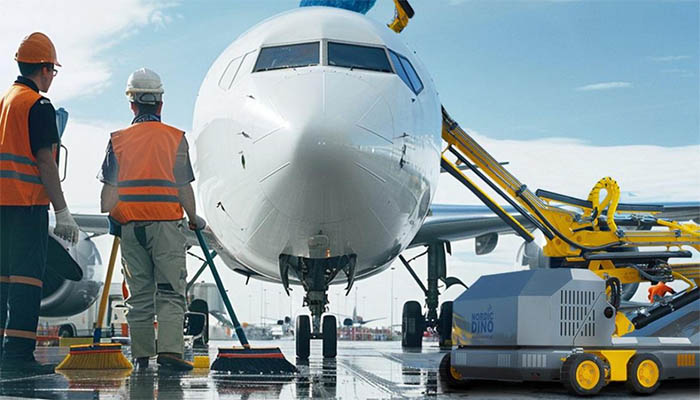When aircraft fly or are parked in conditions where there is moisture in the air at temperatures at or below 0°C, ice forms on their surfaces, creating a significant safety hazard for flight. However, pure water does not freeze until below 0°C, as the formation of ice typically requires the presence of small particles or another solid to act as a nucleation site. The first line of defence against icing is planning flights to avoid conditions conducive to ice formation. However, due to the demands of commercial aviation, which often involves flying at supercooled high altitudes, into visible moisture, and in climates prone to icing, airlines must apply de-icing fluids before take-off and while aircraft are parked at the gate or utilize advanced anti-ice systems onboard the aircraft to prevent ice accumulation. Nordic Dino, the world’s leading designer of automated aircraft washing solutions and a subsidiary of Avia Solutions Group, explains how its cleaning robot enhances the effectiveness of de-icing strategies.
“Air Florida Flight 90, Turkish Airlines Flight 301, and China Eastern Airlines Flight 5210 are just some of the fatal accidents where the accumulation of ice on the wings, tail, or control surfaces led to disaster,” Veronika Andrianovaite, Chief Commercial Officer (CCO) of Nordic Dino Robotics AB, said.
Among aviation disasters caused by ice, Andrianovaite notes that the 2009 loss of Air France Flight 447 served as a particularly stark reminder of the science behind ice formation. In this accident, the aircraft inadvertently stalled due to a failure of avionics systems, which was caused by ice formation on the pitot-static systems. This led to a loss of airspeed and altitude information. These systems, equipped with heating elements designed to prevent ice formation, were unable to do so because the water in the air was supercooled and free of impurities, meaning it froze immediately upon contact with any surface, including the aircraft.
“This accident teaches us how ice bonds with any surface, and it requires impurities to form, which is why we ensure aircraft are as clean as possible from any particles, so that surface treatments can work effectively,” Andrianovaite explained. “The surface of an aircraft is designed to be aerodynamically smooth, and this very design feature can lend itself to ice formation, which is why any measure to combat it is particularly crucial.”
Andrianovaite explains that Nordic Dino and ground handlers benefit from a wide array of scientific research on ice formation, adhesion, and icephobic tendencies. This scientific research results in a comprehensive understanding of the chemical properties that need to be considered when treating aviation surfaces. Research conducted by chemical societies, and even NASA, on the formation of ice, contributes valuable knowledge to combat its formation.
For Nordic Dino, the presence of pollutants and dirt on an aircraft facilitates more solidified ice formation on wing surfaces, which diminishes the effectiveness of de-icing agents. The benefit of cleaning aircraft lies in the reduction of areas where ice can form and adhere, since dirt and contamination serve as nucleation sites, making ice formation more likely to occur.
“When de-icing fluid is applied to the surface, it is assumed that frost and ice will fall off the aircraft during the acceleration of take-off,” Andrianovaite explained. “While particles frozen within ice can weaken its structure, dirt and chemicals on the surface can increase ice adhesion, potentially leading to ice remaining at speeds beyond V1.”
Andrianovaite added that Nordic Dino’s robot has led to a reduction of 4,000 liters of water per wash. This reduction in water use, particularly during wintertime operations, would contribute to less ice formation on the ground, thereby reducing the risk of slips and falls, as well as ice formation on aircraft surfaces.
“We haven’t just built an automated solution,” Andrianovaite said. “We have developed a well-thought-out tool for aviation that offers benefits for aircraft surfaces that might not be immediately apparent on the surface level.”
About Nordic Dino:
Nordic Dino is the world’s leading producer of self-contained robots for automatic aircraft washing and aircraft cleaning services. The company has received worldwide recognition for continuous efforts to make the aviation industry more sustainable and efficient.
Nordic Dino Robotics is part of the Avia Solutions Group family, the world’s largest ACMI (Aircraft, Crew, Maintenance, and Insurance) provider, with a fleet of 221 aircraft, and a parent company of SmartLynx, Avion Express, BBN Airlines Indonesia, KlasJet, Magma Aviation and more. The group also provides a range of aviation services including, MRO (Maintenance, Repair, and Overhaul), pilot and crew training, ground handling, as well as a variety of associated services. Supported by 14,000 highly skilled aviation professionals, the group operates worldwide.
For more information: www.nordicdino.com and www.aviasg.com





Be the first to comment on "Cleaner Aircraft Less Likely to Develop Icing Buildup"